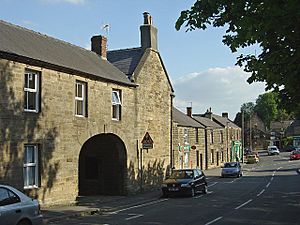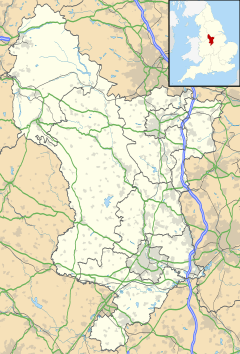Crich facts for kids
Quick facts for kids Crich |
|
|---|---|
 Bowns Hill, Crich |
|
| Population | 2,821 (2001 census) |
| OS grid reference | SK3454 |
| Civil parish |
|
| District |
|
| Shire county | |
| Region | |
| Country | England |
| Sovereign state | United Kingdom |
| Post town | Matlock |
| Postcode district | DE4 |
| Dialling code | 01773 |
| Police | Derbyshire |
| Fire | Derbyshire |
| Ambulance | East Midlands |
| EU Parliament | East Midlands |
| UK Parliament |
|
| Website | Crichweb |
Crich (pronounced Cry-ch) is a village and local area in Derbyshire, England. It's a small community that includes the villages of Fritchley, Whatstandwell, and Wheatcroft. In 2011, about 2,898 people lived in the Crich area.
The village is famous for two main things. One is the National Tramway Museum, where you can see and ride old trams. The other is a tall memorial tower called Crich Stand. This tower sits on top of Crich Hill and remembers soldiers from the Sherwood Foresters regiment who died in wars, especially World War I.
Contents
History of Crich
Crich has a long history. Around the year 1009, an old document shows that King Æthelred the Unready officially recognized Crich as an important place. This document also mentioned that Crich was linked to other nearby areas.
The local church, Saint Mary, is very old. Parts of it were built in the Norman style, which means it's from the 11th or 12th century. Later, in the 14th century, parts were changed to the Decorated and Perpendicular Gothic styles. Crich also has a Wesleyan Chapel that was built in 1770.
In 1734, a workhouse opened in Crich. This was a place where people who needed help could stay. It could hold up to 40 people and also took in people from other nearby villages.
Chase Cliffe is a large house near Crich. It was built between 1859 and 1861 in a style that looked like old Tudor houses.
Quarrying in Crich
Crich is known for its limestone. This type of rock is found here because the village is on a special outcrop of Carboniferous limestone. People have probably been digging for limestone in Crich since Roman times.
In 1791, two men named Benjamin Outram and Samuel Beresford bought land to start a quarry. They needed limestone for their new ironworks at Butterley. This quarry became known as Hilt's Quarry. The limestone was moved down a steep track called the Butterley Company Gangroad to the Cromford Canal. They also built lime kilns nearby to turn the limestone into lime, which was used by farmers and for building. The Butterley Company ran this quarry until 1933.
The gangroad was very steep, dropping about 300 feet in just one mile. At first, wagons rolled down by gravity, and horses pulled them back up. But in 1812, an engineer named William Brunton created something amazing here: his "Steam Horse locomotive". This was an early type of steam engine that could move the wagons.
Later, in 1840, George Stephenson (who built many railways) found coal nearby. He realized that burning limestone would be a good way to use the leftover coal. So, he leased Cliff Quarry and built more lime kilns. These were connected by another track, including a very steep part called "The Steep."
Cliff Quarry stopped working in 1957. However, a small part of it reopened later until 2010. The eastern part of the quarry was bought by the Tramway Museum in 1959.
Hilt's Quarry closed in 1933 and is now empty. For many years, a company used it to store certain industrial materials. However, local villagers campaigned for this to stop, and it did in 2002. In 2004, the government supported a ban on further storage, and the company is now required to clean up and restore the site.
Crich Stand Memorial Tower
The memorial tower, known as 'Crich Stand', was finished in 1923. It was built to remember the 11,409 soldiers from the Sherwood Foresters Regiment who died in World War I. Later, it was also dedicated to those who died in World War II.
The tower is on a limestone hill about 1,000 feet above sea level. It's a special spot because you can see it from far away. It also offers great views of both Nottinghamshire and Derbyshire, the two counties where the regiment's soldiers came from. Every year, on the first Sunday in July, people make a special trip to the tower to remember the soldiers.
There are other plaques at the tower too. They remember soldiers who died in the Sherwood Foresters regiment between 1945 and 1970. They also honor those from the Worcestershire and Sherwood Foresters Regiment (from 1970 to 2007) and the Mercian Regiment (since 2007).
National Tramway Museum
Beneath Crich Stand, you'll find the National Tramway Museum, also called Crich Tramway Village. This is the biggest museum in the UK dedicated to trams and tramways. The museum has over 80 trams, some built as early as 1873!
The museum has several exhibits and a recreated old-fashioned street. On this street, you can find a working pub, a cafe, a shop, and old street lights. Many of the trams can still run, and you can ride them through the period street and out into the countryside. The track is about 1.6 kilometers long. Along the way, you can see the front of the old Derby Assembly Rooms building, a recreated Victorian park, and a path with sculptures in the woods. There's also a display about the local lead mining history.
Gallery
See also
 In Spanish: Crich para niños
In Spanish: Crich para niños








